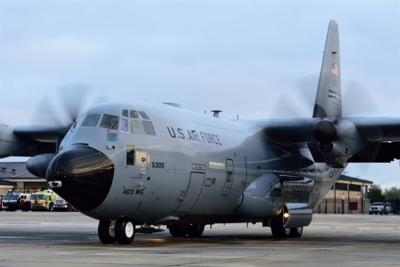Work Does Not End With The Hurricane Season
Some people might think that when hurricane season comes to an end, so does the mission of the Air Force Reserve “Hurricane Hunters.” But that’s not the case.

For members of the 53rd Weather Reconnaissance Squadron, also known as the Hurricane Hunters, the hurricane tasking is only one part of their overall data-gathering mission. Hurricane Hunters track winter storms off the East and West Coast of the United States and in the Gulf of Mexico. While the normal flying season for these missions runs Nov. 1 to March 31, some missions can take place either before or after these dates depending on the weather that season.
“So far this season, the Hurricane Hunters have flown two winter storm missions, one today and the other Jan. 3. The data from these and other winter storm missions help forecasters determine what type of weather conditions these storms might bring to coastal communities and even further inland, whether it be freezing rain, sleet, ice or snow.” said Maj. Christopher Dyke, 403rd Operations Group weather standards and evaluation officer.
Dyke said the Hurricane Hunters fly their WC-130J Super Hercules aircraft on predetermined tracks to collect weather data such as air pressure, temperature, humidity, wind speed and direction, and global positioning system information. The dropsondes used to collect this data are released from the aircraft through a specialized cannon and parachute down toward the water’s surface. “We collect this dropsonde data, which gives the modelers a full profile – from 30,000 feet down to the surface – of what the atmosphere looks like. That data gets ingested, or pulled, into the model, and that marks ‘hour zero,’” said Dyke, referring to the starting point for the winter storm forecast models projected by meteorologists at the National Centers for Environmental Prediction, a division of the National Oceanographic and Atmospheric Administration. “So, that helps bring the model in line with reality so that it reduces the error as it goes forward.”
While the NCEP collects some of its forecasting data from buoys in the water and weather satellites in orbit, Dyke said the data the Hurricane Hunters gather can help fill in key information gaps in the NCEP forecasting models. “For those areas where you don’t really have a lot of data to work with for initializing or starting the model, those are the areas where we help supplement it with data,” said Dyke, who mentioned this data can provide 20 to 25 percent improvement in forecasting accuracy.
Dyke noted some of the main differences between the winter storm and hurricane hunting missions. While the National Hurricane Center provides the Hurricane Hunters with taskings for hurricane missions, the NCEP actually provides them with flight paths, called synoptic tracks, for the winter storm missions, which can last anywhere from five to 12 hours depending on the storm’s location and number of drop points for the dropsondes. “Also unlike hurricane missions, which take 53rd WRS aircrews into and through the storms, winter storm missions have the Hurricane Hunters fly ahead of storm systems, releasing dropsondes anywhere from 27,000 to 32,000 feet to gather a vertical profile of data for NCEP forecasters to use in their weather models.” said Maj. Brad Roundtree, 53rd WRS pilot. “Hurricane flights, however, normally occur no more than 10,000 feet above sea level. We actually try to fly as low as possible and straight through the storm (for hurricane missions) to pinpoint the
center of circulation and gather all the data for forecasting the speed and movement of the storm, whereas for a winter storm we fly as high as possible and try to get out in front of it to take measurements of the atmosphere that it’s actually going to be moving through.”
Another difference between hurricane and winter storm missions is the data transmitted by the Hurricane Hunters is gathered solely through the dropsondes, whereas hurricane flights incorporate a horizontal data profile gathered from instruments on the plane as it flies through the storm, as well as visual information gleaned by the 53rd WRS aerial reconnaissance weather officers from watching the water’s surface, such as wave activity. “Overall, this information can help emergency managers and government officials determine what actions they may need to take in preparation for these winter storms.” said Roundtree. “Just like the hurricane mission, this is all to help cities and local governments to prepare for these events so they can save time and money on the amount of preparations they do, and most importantly help to save lives with these preparations,” said Roundtree.
(Image provided with USAF news release)
 ANN's Daily Aero-Term (05.01.24): Say Altitude
ANN's Daily Aero-Term (05.01.24): Say Altitude ANN's Daily Aero-Linx (05.01.24)
ANN's Daily Aero-Linx (05.01.24) Classic Aero-TV: Korean War Hero Twice Reborn
Classic Aero-TV: Korean War Hero Twice Reborn Airborne 04.29.24: EAA B-25 Rides, Textron 2024, G700 Deliveries
Airborne 04.29.24: EAA B-25 Rides, Textron 2024, G700 Deliveries Airborne Affordable Flyers 05.02.24: Bobby Bailey, SPRG Report Cards, Skydive!
Airborne Affordable Flyers 05.02.24: Bobby Bailey, SPRG Report Cards, Skydive!



